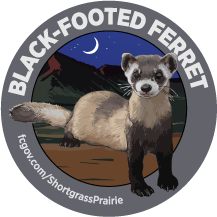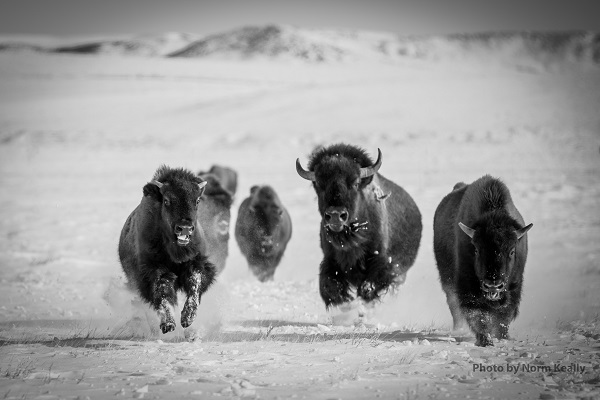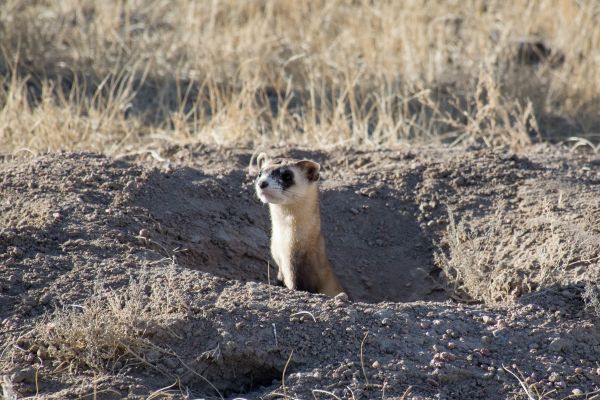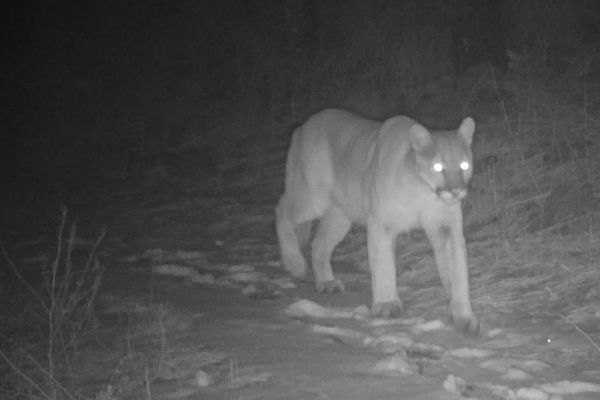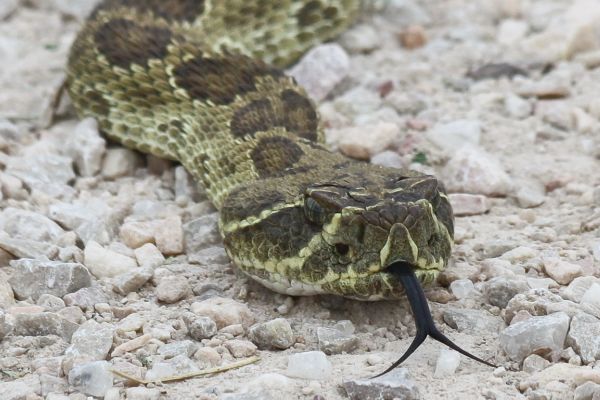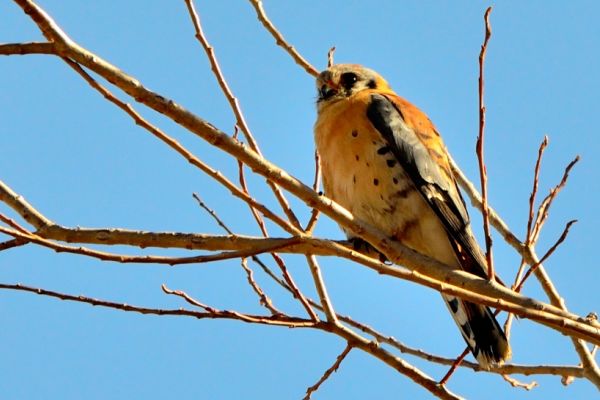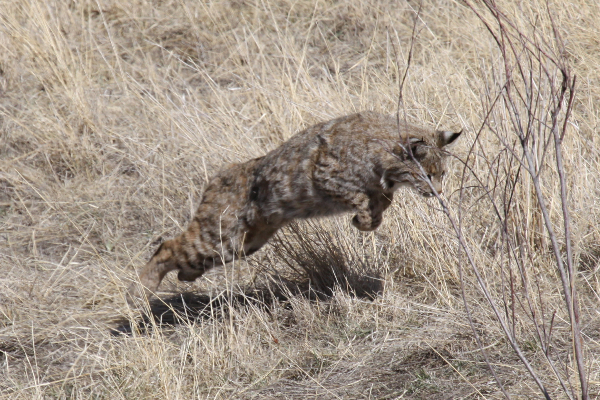Wildlife at Natural Areas#
The City of Fort Collins is a great place for wildlife because it's located where the mountains meet the plains. A remarkably rich diversity of wildlife can be seen in your local natural areas. Follow these safety guidelines:
- Keep your distance. Use binoculars to get a close-up view. If a creature changes its behavior because of your presence, you are too close.
- Keep your dog on leash. Follow the B.A.R.K principles to keep you and the wildlife safe.
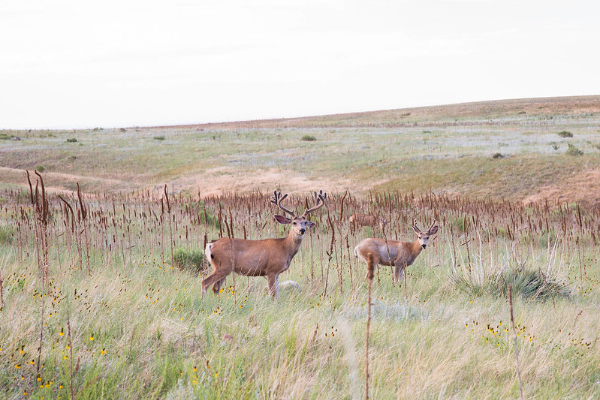
Deer at Coyote Ridge Natural Area
Best Places To View Wildlife#
Many natural areas are great for wildlife. If you'd like to maximize your wildlife viewing try exploring one of these natural areas.
Key Habitats: Shortgrass prairie, wetlands.
Look for: Prairie dogs which support bald eagles and hawks, especially in the winter. The raptor observation building, off Shields Street is a bird blind, so its a great place to see raptors. You may also see horned lizards, ground-nesting songbirds, butterflies, rabbits, coyotes and foxes. Mountain lions are occasionally sighted. Rattlesnakes are common and abundant. If you see a rattlesnake, remain calm. Rattlesnakes are not aggressive. Give it lots of space and walk around the snake or wait for it to move away.
Key Habitats: Previously mined gravel ponds designed with a gradual shoreline, wetlands.
Look for: Abundant waterfowl are attracted to the gradual shoreline and abundant wetland plants. You might see a high diversity of birds including red-winged and yellow-headed blackbirds, egrets, herons, sandpipers, pelicans and killdeer. Also look for warblers, kingbirds and song sparrows which nest in the uplands. Other wildlife includes painted turtles, foxes, muskrats, and both mule deer and white-tailed deer.
Key Habitats: Grasslands, foothill shrublands, ponderosa pine forest.
Look for: Significant species such as elk, deer, black bear, mountain lion, black-tailed prairie dog, golden eagle, grasshopper sparrow, and black-chinned hummingbird. You may see wild turkeys or bobcat too. The Mosss elfin butterfly and Townsends big-eared bat are state-listed species of concern that are found at Bobcat Ridge.
Key Habitats: Shortgrass prairie, foothills shrubland, ponderosa pine forest, Dixon Reservoir and associated riparian forest.
Look for: The variety of habitat here makes it rich with wildlife, in fact, over 150 bird species have been seen here. The reservoir supports migrant waterfowl and other waterbirds. Pelicans, ospreys, and bald eagles may be seen. Mature cottonwoods and willows provide habitat for migrant songbirds, including vireos and warblers. Red-tailed hawks nest in the pines. Mule deer are common in the forest, especially in winter. A variety of small mammals are found here including prairie dogs. Elk and mountain lions are occasionally sighted.
Key Habitats: Nearly pristine shortgrass prairie, foothills shrubland.
Look for: Pronghorn, elk and deer. The rare swift fox lives here, although a glimpse is rare. Mountain lions, bobcats and bears have been sighted. Soapstone Prairie supports many grassland bird species, including: burrowing owl, mountain plover, McCowns longspur, chestnut-collared longspur, long-billed curlew, horned lark, lark bunting, grasshopper sparrow, and loggerhead shrike. Birds of prey include raptors such as eagles, hawks and falcons, as well as owls and harriers. Nesting birds of prey on Soapstone Prairie include golden eagle, ferruginous hawk, Swainsons hawk, red-tailed hawk, prairie falcon and American kestrel.
Wildlife Cameras
The City of Fort Collins Natural Areas Department works with community partners to monitor wildlife on several natural areas.
At Bobcat Ridge Natural Area, we partner with Rocky Mountain Cat Conservancy. City of Fort Collins volunteers regularly check the cameras. The images confirm species such as elk, deer and mountain lions really do share our trails. To find out more about the Bobcat Ridge Wildlife Camera Project, Cameras, Communities and Conservation read this Camera Project Summary.
Learn about Northern Colorado's Wildlife#
Wildlife in Shortgrass Prairie Ecosystems#
The Natural Areas Department has created stickers to highlight important species in shortgrass prairie ecosystems and you can collect them all! Explore some of the unique wildlife that calls Soapstone Prairie home and to see your conservation dollars at work.
Wildlife Checklists#
The Great Outdoors Is No Place For Cats#
You can protect your cat and be a responsible owner by preventing it from being lost, killed or stolen- keep your cat indoors. Youll be helping birds too. Outdoor cats kill a surprising number of birds and small mammals. The American Bird Conservancy estimates that outdoor and feral cats kill 2.4 billion birds a year in the U.S. A recent study by the Smithsonian Conservation Biology Institute found that cats were responsible for about half the deaths of gray catbirds (Dumatella carolinensis) in a suburban environment.
Domestic cats are not part of natural ecosystems, they compete with native predators, and they can transmit diseases to wildlife. Indoor cats live longer, healthier lives. City code section 4-93 prohibits pet animals at large, including cats. For these reasons, the City of Fort Collins Natural Areas Department encourages you to keep your cat indoors. Learn more from the American Bird Conservancy
